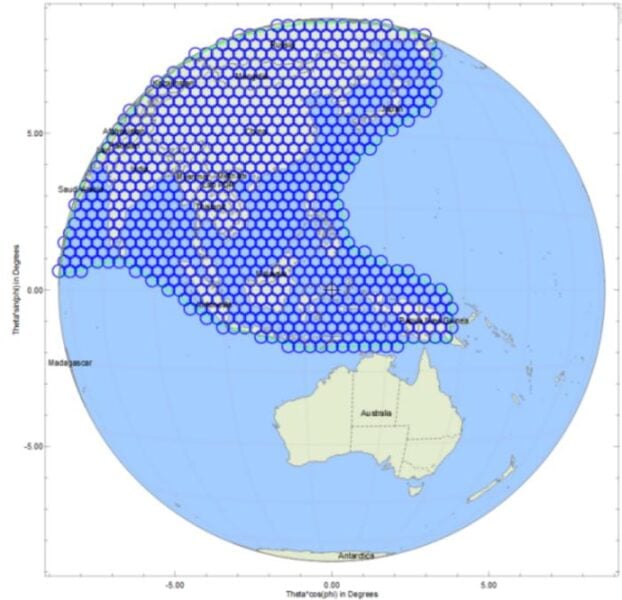Researchers have developed a novel method for designing active multi-beam antennas, potentially revolutionizing satellite communication for future 6G networks. The new approach, detailed in a recent study, promises to overcome long-standing challenges in very high throughput satellite (VHTS) systems, offering improved coverage and unprecedented data speeds.
Tackling the Limitations of Traditional Satellite Antennas
Satellite communication systems are evolving rapidly to meet the ever-growing demand for high-speed, global connectivity. Current high-throughput satellites typically employ multi-beam antennas to cover large areas, using a 7-color frequency reuse scheme. These systems aim to provide coverage with over 500 beams, but traditional antenna designs face significant hurdles in achieving this goal.
Existing multi-beam antenna technologies fall into two main categories: multi-aperture and passive multi-feed systems. Multi-aperture antennas, composed of 3-4 reflector antennas, struggle with reduced gain and increased signal distortion at the edges of large coverage areas. Passive multi-feed systems, while able to compensate for some edge beam issues, become prohibitively complex when scaled up to the 500+ beams required for next-generation satellites.
Active multi-feed antennas, commonly used in mobile communication satellites, offer some improvements but still face limitations. These systems typically use large mesh reflectors with multi-feed arrays to achieve high-level beam overlap. However, they struggle to meet the strict requirements for VHTS systems, particularly in terms of carrier-to-interference ratio (C/I) and frequency reuse efficiency.
A New Approach: AI-Powered Antenna Optimization
To address these challenges, the researchers propose a novel design method for active multi-beam antennas. Their approach leverages multi-target cooperation and multi-feed amplitude and phase weighted optimization algorithms. The key innovation lies in using artificial intelligence (AI) techniques to efficiently solve complex nonlinear optimization problems.
The method involves eight key steps:
1. Creating a GRASP (General Reflector Antenna Software Package) model of the multi-beam antenna
2. Co-simulating beam parameters using Python-GRASP
3. Constructing and training a convolutional auto-encoder proxy model
4. Validating the model’s fit
5. Initializing and debugging a max-min algorithm
6. Calculating residual values for spatial electric field sampling points
7. Iteratively optimizing until performance targets are met
8. Verifying results using GRASP
This AI-powered approach allows for rapid optimization of beam excitation coefficients, balancing multiple performance objectives simultaneously. The resulting antenna design shows remarkable improvements in compensating for scanning loss, a common issue in large coverage areas.
Why it matters: As we move towards 6G networks, satellite communication will play a crucial role in providing global, high-speed connectivity. This new antenna design method could significantly enhance the capacity and coverage of satellite networks, potentially enabling terabit-per-second (Tbps) level communication. Such advancements are essential for supporting emerging technologies like the Internet of Things (IoT), autonomous vehicles, and smart cities on a global scale.
The researchers applied their method to design an active multi-beam antenna based on VHTS technical requirements. The receiving antenna features an aperture of 3.2 meters and a focal length of 5.8 meters, while the transmitting antenna boasts a 5.0-meter aperture and 9.0-meter focal length.
Simulations of this design demonstrate impressive performance metrics. The antenna achieves ultra-high gain exceeding 50 dBi and a carrier-to-interference ratio (C/I) of more than 18 dB across nearly a thousand beams. These figures represent a significant leap forward in satellite communication capabilities, potentially supporting communication capacities at the terabit-per-second level.
While these results are promising, several questions remain. The practical implementation of such a complex antenna system on a satellite platform presents significant engineering challenges. Issues such as power consumption, thermal management, and long-term reliability in the harsh space environment will need to be addressed. Additionally, the integration of this advanced antenna technology with existing satellite communication infrastructure and ground systems will require careful planning and potentially significant investment.
As the research progresses, it will be crucial to validate these simulation results through real-world testing. The transition from theoretical models to functional prototypes and eventually to operational satellite systems will likely involve further refinements and optimizations. Nonetheless, this innovative approach to antenna design represents a significant step forward in the development of next-generation satellite communication systems, bringing us closer to the reality of global, high-speed connectivity in the 6G era.
If our reporting has informed or inspired you, please consider making a donation. Every contribution, no matter the size, empowers us to continue delivering accurate, engaging, and trustworthy science and medical news. Independent journalism requires time, effort, and resources—your support ensures we can keep uncovering the stories that matter most to you.
Join us in making knowledge accessible and impactful. Thank you for standing with us!

